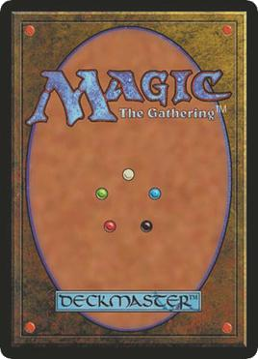I'd like to revisit the format questions I asked in a previous post, and check to see how I've included those in the cube.
1. Players Need All of Their Lands: No Land or "Any-Permanent" Destruction, No More Blind Mill or Discard without it ending the game.This was at the forefront as I was considering removal slots and no direct removal is able to hit lands, I considered land-evening effects like Restore Balance and Limited Resources but instead opted for Mythos of Snapdax.
I don't know that it's 100% worked out for indirect removal, that said there is no blind mill in the cube...ish, I'm not couting Shenanigans. Hand-control is at the forefront of the discard archetype, but I wanted to be careful about my inclusions Mesmeric Fiend and Brain Maggot enable the archetype without fully locking out a play, Cabal Therapist is powerful but doesn't hit lands, and Gunk Slug is amazing in this small-deck format. I did include discard which could include lands. Let's review what was included:
Cabal Interrogator and Hollow Specter both have a natural bias against land cards at the opponent's discretion, making it harder to mana-screw your opponent, so I think they arguably answer the mandate. Pulse of the Dross was included because it recurs itself, and it extends the same logic as the reveal
 's natural bias against lands, but I worry reveal-three pick-one is too powerful of an exchange for the mana it's going on the watchlist.
's natural bias against lands, but I worry reveal-three pick-one is too powerful of an exchange for the mana it's going on the watchlist.Augur of Skulls fits the Aristocrats archetype well, and arguable is a win condition for the Discard archetype. It's powerful, but fits the cube well enough I'd like to make an exception. Also going on the watchlist. 2. The Clock is Different (the game has no end): Aggro decks shouldn't have be able to outpace lategame payoffs. Boards need to be playable after the cards have been played, or draws will never work.
Yeah, super-duper did this. Most of the card recur themselves, aggro strageties are built around getting spells out faster, most strategies have mana sinks to enable a mid-game race. Many of the decisions of the decks should come down to the combat step, and damage-clock should be a big consideration in drafting.
3. Many Cards End their Usefulness in Exile: Graveyard Effects are metered to this, but return from exile is a win-condition effect.To answer this I tried to limit the amount of exile-removal, but not remove it entirely. Exile should be a powerful effect that you are reaching into to (ideally) turn the tables and win a game Anguished Unmaking is in there specifically because Vindicate hits lands. These are the only cards that specifically end the card's playability with exile.
By contrast, exile is a useful zone, and there are plenty of cards in the cube that make use of it in interesting ways. Oblivion Ring-likes can be powerful tools. The answer to these Riftsweeper is clunky but I think it still has usefulness as a sideboard staple when counteracting an effect that makes up ~5% of the cube.
There's also suspend cards that interact with exile: Arc Blade, Epochrasite and Mox Tantalite, which Riftsweeper is not perfect for, but can speed up.
4. Draw makes low-curve (aggro) decks faster, and matter less to high-cmc (late game) decks.: 3-4CMC draw does not matter, cantrips/cycling/draw+effect is stronger on Lower CMC cards. Scry is an aggro effect, and allows for consistency in late game decks.Cycling was a big focus in the landbase I've been working on, but I don't think I did a good job on including enough Scry and Cantrips. This is definitely something to deep-dive on, and look for good places to swap-in utility draw.
5. Mulligans are orders of magnitude more consistent than 30-card deck drafts (~300x more): Decks can run fewer lands and still hit gas. Aggro strategies are simply more available when needed and midrange strategies are available when needed.I took out Sentinel Dispatch for this reason, and you'll also notice an absence of Leylines (Leyline of Lightning etc.) and no Chancellors (Chancellor of the Spires etc.) also no Gemstone Caverns and no Providence.
I also took advantage of this to limit the number of colored mana sources, because you can essentially guarantee that ETB-tapped lands enter T1-2, but idk if that's important. I also focused on colored mana sources that can be utilized in that aggro strategy with Cycling Lands and the Horizon Lands.
Perhaps there's some more that I can do to take advantage of this, and on the next patch I should consider ways to encourage more aggro strategies of all sorts. 6. Lands have a limit, but mana doesn't. Cards like Storage Lands, etc make a lot out of very little.
Using the 40% heuristic of standard, decks run 6 lands. Mulligans can pull that number easily down to 5 with just basic lands and no fixing. Curves mutate in favor of 1 and 2 drops, and shy away from 5+.
I don't have as many 1-drops as I might, but I do have a good number of 1-mana sinks for the late game. There are certainly excellent 2-drops. As I said before, I've removed land destruction. There is also only one card that costs above 5-mana, and only three 5-drops
I've shied away from the implication that technically limitless mana is a good thing. It enables  -spells and big spells and that's not necessarily a good thing. Scalability is powerful, but
-spells and big spells and that's not necessarily a good thing. Scalability is powerful, but  >4 is not the power level I want involved. I've limited the number of
>4 is not the power level I want involved. I've limited the number of  -spells in the cube to try to keep things:
-spells in the cube to try to keep things:
For further consideration, these are also the abilities that can be activated more than once in a turn:
Limiting the number of large-mana generators certainly limits the amount of mana involved in each turn's arc, but it also avoids cheap casting of infinitely-repeatable spells. Braid of Fire is a broken spell that only works during upkeeps, limiting which repeatable spells I could include. The other cost, the opportunity cost of not including Molten Slagheap is not super high either, I'd rather include the aggro-enabling Canyon Slough. 7. Deck End is inevitable, and the deck will never be larger than 15 cards. Deck size victories like Laboratory Maniac etc. lets a player win without strategy.
There's not a lot to say about this, I've made a point of not rewarding regular card draw or empty deck states (although I'm not above, say Arc-Slogger or Leveler in the future).
Further, I've included a few shuffle-into-library effects that let decks keep playing:
Yeah, uh. Think I got this one down. Aristocrats and Burn are purely built on this. Every deck has some ability to do this. Prior to play-testing, I can't judge how fast each recursion works but lets see how this goes.
9. Removal and Deactivation needs to be intentional. Removal should have threatening targets, and should come at a fair price. Effects that limit lines of play need to be susceptible to removal.There is no indestructible in the cube, and I've made a point of having my limiters on bodies, either creatures or enchantments.
I want removal to feature strongly, that's how we interact, their impacts should be felt and limited. I think I did a great job on that. Playtesting will be the final judge of this. 10. Magic was not designed for this. Enabling this might require some card editing. No Card is Immutable.
This was the main reason I moved out of WUBRG. Remaining in a shard ensures that I have all types of permanent removal (creature, artifact, and enchantment removal) but limiting the width of each deck (and ensuring we have a lot of deck variety within the archetypes).
Converting 
 to
to  opens each color up to more options outside their color, and is a natural way of card editing.
opens each color up to more options outside their color, and is a natural way of card editing.
The Watchlist
Cards that if they're gamebreakingly naughty need to be replaced:


